Water Dog: Born to Hunt
Tracing the fascinating origins of the water dog
Tracing the fascinating origins of the water dog

For generations, retrievers have leapt into icy waters and bounded across flooded fields in pursuit of fallen ducks and geese. And waterfowlers have always loved retrievers for such heroics as well as for their unflinching loyalty. This affection has been a constant presence in waterfowling's history.
In England, training guides for duck dogs date back to the early 1600s. On the other side of the Atlantic, all types of hunting dogs accompanied their European masters to the New World.
As American waterfowling grew so did the number of dogs bred specifically to retrieve in the water. For example, fishing villages along Newfoundland's rocky shores became known for producing a hardy strain of water dogs. By the mid-1800s, Newfoundland's retrievers were in high demand for their intelligence and strong swimming ability.
As a result of this popularity, Newfoundland is the origin of several modern retrievers.
Today, the duck dogs are a distinct, yet diversified, group. The differences among them are the product of more than 200 years of selective breeding. This article looks back at the histories of 10 breeds that continue to serve waterfowlers as loyal companions and valuable partners.
As a distinct breed, the American water spaniel became established sometime in the second half of the 19th century. Its early history is not well documented, and its ancestors could include the Irish water spaniel and curly-coated retriever. Yet, most historians agree hunters developed the breed in the region around the Fox and Wolf river valleys of east-central Wisconsin.

Photo ChrisSmithArt.com
American water spaniels are among the smallest duck dogs, standing only 15 to 18 inches high. Some attribute the dog's small stature to the notion that Wisconsin hunters wanted a dog that would take up little room in their boats. In time, the breed's popularity among waterfowlers earned it recognition as the state dog of Wisconsin.
The Boykin spaniel is the state dog of South Carolina and the newest member of the duck dog club. According to the Boykin Spaniel Society, the breed's roots can be traced to the first decade of the 20th century when Whitaker Boykin, of Boykin, S.C., received a dog from longtime hunting partner Alexander White. Boykin's new dog didn't have a fancy pedigree. In fact, it had been a stray. White had taken in the spaniel, named it "Dumpy," and recognized it had strong retrieving instincts.
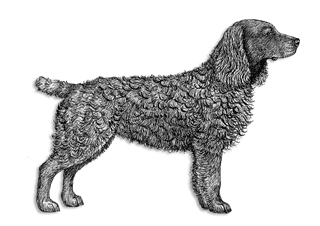
Photo ChrisSmithArt.com
Under Boykin's training, Dumpy learned to be a skilled duck retriever, and this one-time stray became the foundation stock for the Boykin spaniel. Over the next few decades, the Boykin was intentionally kept small so that it would better fit in the boats used by waterfowlers along South Carolina's Wateree River.
Despite being the state dog of Maryland, the Chesapeake Bay retriever has a history clouded by speculation and legend. Tradition claims the breed originated from two dogsSailor, a red male, and Canton, a black female.
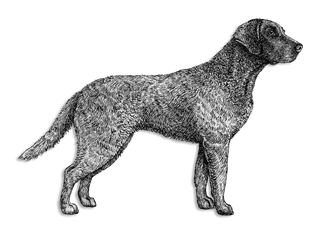
Photo ChrisSmithArt.com
In a letter dated 1845, George Law wrote that in 1807 he rescued young Sailor and Canton from a sinking ship that had left Newfoundland bound for England. Law then brought the pups to Baltimore and gave them to separate owners. Sailor was eventually purchased by Maryland's governor and settled on the Eastern Shore. Canton was owned by Dr. James Stewart and remained just south of Baltimore.
Known for their retrieving ability and toughness, these two dogs and their descendents were bred with a variety of other dogs, including Irish water spaniels, curly-coated and flat-coated retrievers, setters and even coonhounds. By the mid-1880s, a definite breed had been established, and the Chessie was the first retriever to be recognized by the American Kennel Club (AKC).
Many dog experts believe that the curly-coated retriever is one of the oldest retriever breeds. According to the AKC, the breed originated in England and was the product of a cross between the now-extinct English water spaniel (or possibly the Irish water spaniel) and retrieving setter. In the mid-1800s, curly coat breeders supposedly crossed their dogs with the now-extinct St. John's water dog, which arrived in England from Newfoundland aboard the ships of cod fishermen.
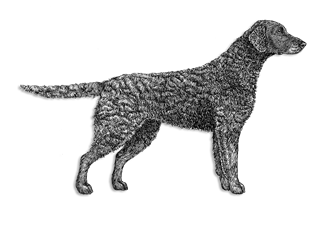
Photo ChrisSmithArt.com
Later that century, curly coats were reportedly crossed with the standard poodle to give the curly coat breed tighter, more water-resistant curls. These modern curly coats were exported for hunting ducks in Australia and New Zealand beginning in the late 1880s and sent to the United States in the early 1900s.
England's Flatcoated Retriever Society notes that the first flat coats were a cross between the St. John's water dog, the larger spaniels, setters, pointers, and, later, collies. This new breed, at first called the "wavy-coated" retriever, was popular among Britain's sportsmen and gamekeepers. The first recognized flat coat was called "Wyndham," and it appeared at a dog show in England in 1860.
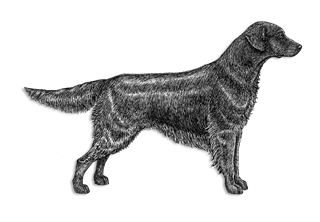
Photo ChrisSmithArt.com
The AKC recognizes gamekeeper J. Hull and breeder S.E. Shirley as the two figures who did the most to create and develop the flat coat. While flat coats continue to be prized as both field and show dogs, they lost ground to goldens and Labs over the course of the 20th century.
Golden retriever fans have one man to thank for introducing and popularizing this breed. The Golden Retriever Club of America says that Sir Dudley Majoribanks, later Lord Tweedmouth, wanted to create a breed of sporting dog that could thrive in his native Scottish Highlands.
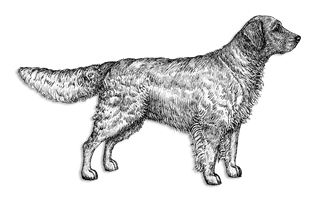
Photo ChrisSmithArt.com
In pursuit of his goal, Majoribanks bought "Nous" in 1865. This dog was the only yellow pup in a litter of black flat-coated retrievers and would become the founding stock of the golden retriever line. Majoribanks soon bred Nous to "Belle," one of his Tweed water spaniels (a now-extinct breed). In turn, their offspring were bred to a flat coat, another Tweed water spaniel, and an Irish setter. The AKC adds that the bloodhound was another breed included to form the modern golden line.
Goldens arrived in North America in the 1890s and have steadily increased in number ever since. In 2005, this dog was the second-most popular breed in AKC registrations.
True to its name, this breed originates in Ireland. The Irish Water Spaniel Club says that two now-extinct strains of Irish water dogthe south country water spaniel and the north country water spanielwere crossed in the first half of the 19th century to produce today's breed. Although distinct, these two strains both contributed to the modern dog's curly, liver-colored coat and strong swimming ability.
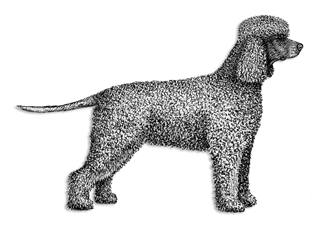
Photo ChrisSmithArt.com
History credits Dublin sportsman Justin McCarthy for taking the biggest step toward establishing a distinct type. His prize dog, "Boatswain," was born in 1834 and would become one of the key pure-type stock figures in the breed's history.
These dogs were popular upon their arrival to the United States and Canada in the late 1800s, but their numbers waned during the 20th century. Despite this trend, the Irish water spaniel has been crossed with many other dogs to influence several modern spaniel and retriever breeds.
Like many modern retriever breeds, the Labrador line developed in England but relied heavily on North American stock. According to breeder Franklin Lord, the Lab's story starts in Newfoundland, where European cod fishermen had been importing and raising a variety of dogs since the 16th century.

Photo ChrisSmithArt.com
For hundreds of years, specific breeds emerged, and English sailors brought these new dogs back with them to Britain. One of these breeds, the St. John's water dog, was a strong swimmer that fishermen had used to retrieve fish and pull their nets ashore. In the early 1800s, the second earl of Malmesbury bought two of these dogs and found them to be excellent duck retrievers. By the end of the 19th century, the third earl of Malmesbury and other aristocratic sportsmen used the descendants of these dogs and other St. John's dogs to develop and establish a distinct new breed. In fact, the third earl is credited for naming this dog a "Labrador."
Historian Bernard Ziessow says the Lab's major introduction to North America came when Americans interested in British-style driven bird shooting brought over gamekeepers from Scottish estates and Labs from English kennels. The Lab's popularity spread throughout America and Canada, particularly after World War II. Today, the Lab is more popular than ever and has been the AKC's most registered dog since 1991.
As its name suggests, the duck-tolling retriever, or "toller," is closely connected with North American waterfowling history. Originally, this dog acted as both retriever and decoy. The word "toll" means "to lure or decoy game." The AKC explains that the playful actions of a toller on the shore enticed curious waterfowl within range of hunters' guns. European hunters had employed this strategy since the 17th century, and they brought a red decoying dog, one of the toller's ancestors, with them when they settled Nova Scotia.
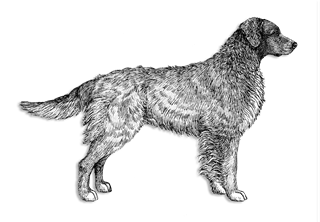
Photo ChrisSmithArt.com
In addition to the red decoying dog, spaniels, setters, retrievers and collie breeds mixed to form the modern line of tollers. This dog was introduced to the United States in the 1960s and has also branched out to Europe and Australia.
For some, this dog may seem an unlikely addition to this group, but in fact, the standard poodle might have been the original duck dog. Used as a hunting companion since the late Middle Ages, the poodle has roots in France, Germany, and perhaps Spain. The breed was well known for its swimming abilities and was popular among European waterfowlers. In 1621 Englishman Gervase Markham published a guide on how to train poodles as retrievers. His instructions included a style of clipping the dog's coat that resembles the grooming pattern popular with today's show poodles.
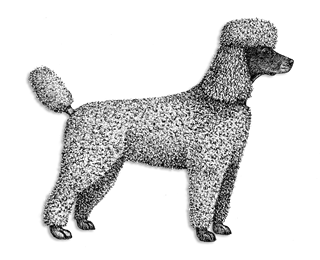
Photo ChrisSmithArt.com
The poodle arrived in North America in the late 1800s. While it became one of the most popular dogs in the United States after World War II, the full-sized standard poodle lost ground to its smaller versions, the miniature and toy poodles. In the field, the poodle never reached the popularity of the golden or Lab.
Ducks Unlimited uses cookies to enhance your browsing experience, optimize site functionality, analyze traffic, and deliver personalized advertising through third parties. By continuing to use this site, you agree to our use of cookies. View Privacy Policy